Numerical Investigations of Soot Formation in a Model Aircraft Combustor
Einleitung
Soot is an undesired particulate pollutant generated from an incomplete combustion of hydrocarbons. Due to its carcinogenic effects on human health and its detrimental impact on climate changes, the soot emission limits for combustion devices have become stricter. Therefore, accurate soot prediction in CFD simulations, both in terms of chemical evolution and particle formation, is of fundamental interest for combustion research. However, soot is a challenging modelling problem due to the interactions between turbulence, chemical reactions and particulate evolution, happening over a large range of time scales. Soot is commonly studied by solving the population balance equation (PBE) that evolves the particle number density function (NDF). The direct solution of the PBE is numerically expensive and therefore of limited feasibility. A computational efficient approach for solving the PBE is the method of moments (MOM). Here the PBE is not solved directly, but only a few lower-order moments of the distribution are tracked. The recently proposed Extended Quadrature Method Of Moment (EQMOM) allows to reconstruct the full NDF from the set of transported moments. The method was successfully applied to predict soot (Salenbauch et al. 2015) and soot oxidation (Salenbauch et al.2019, Wick et al. 2017b) in laminar flames, demonstrating that it yields results almost as accurate as high- fidelity reference simulations. EQMOM solves the long-standing issue of moment methods to describe particle oxidation accurately while keeping the computational efficiency of MOM. The reacting flow in aero-engine combustion chambers is however more complex (Cuenot et a. 2016, Donini et al. 2017, Fiorina et al. 2010, Franzelli et al. 2015). Advanced numerical methods, as large eddy simulations, are currently used in research in order to accurately characterize the details of the turbulent mixing and the interaction with chemical reactions (Gourdain et al. 2009, Fiorina et al. 2016, Wick et al. 2017). The ESTiMatE (Emission Soot Model)/Clean Sky 2 European project has as main goal the study of soot formation in aero-engine conditions, by using advanced turbulence combustion models and soot formation models. In particular, the fundamental issue of soot formation for kerosene-type fuels under lean burn conditions is investigated.
Methoden
A robust cell-centred finite-volume (FV) framework in the open-source toolbox OpenFOAM has been developed for turbulent reacting flows in previous projects. A detailed and accurate C++ library for the evaluation of soot formation using the quadrature-based method of moments approach (Salenbauch et al. 2015, Salenbauch et al. 2019) has been integrated into the CFD solver. The coupled numerical framework provides a wide runtime-selectable flexibility: different turbulence models, e.g. RANS and LES, with several turbulent closures; different combustion models, based on tabulated chemistry and different moment closure strategies to account for the soot particle size distribution, as standard QMOM, Extended QMOM and split- based extended QMOM approach.
Ergebnisse
LES of the Delft Adelaide flame III have been performed to validate the coupled framework. Results of the flow field and soot properties are shown in Fig.1 and 2, respectively. Figure 1 shows a very good agreement of the mean mixture fraction and temperature profiles with the experimental data at three axial locations. Instantaneous contours of some flow variables, soot volume fraction and particle number density are shown in Fig. 2. It is observed that soot particles are mainly formed in the upper part of the flame in the fuel rich region, as indicated by the experiments.




